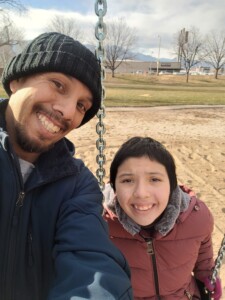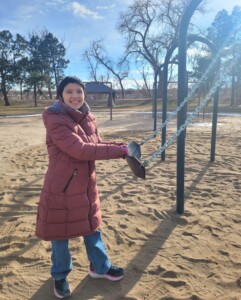
A devoted dad talks about how swing set adventures have helped his young autistic daughter with self-regulation and sensory issues.
I’m driving to Midland Elementary, a favorite school my daughter Monica likes to swing at on the playground.
Monica favors the taller swing set because it provides her with stability and comfort to her various sensory needs.
She was diagnosed with autism and also sensory processing disorder at around age six and currently is 17 years old.

Monica Martinez
We always add pretend play to our swinging sessions at the school because this is much more fun and it gives her motivation.
Monica first warms up by swinging like any kid would do on a swing set.
And then, she wants me to express what I call evil character voices — and then my daughter pushes the invisible person I’m pretending to be.
So we do this for around 15 minutes, which is great for an autistic child or adult with sensory issues like Monica has, and this positive effect can last between six and eight hours throughout her day.
It gives a lot of bang for the buck! And it’s so much fun for her, and me too!

Allow me to describe how the swinging and pushing “evil” creates lots of joy to my daughter’s day.
So first, the act of swinging back and forth is relaxing, so soothing, so calming.
When her body is off the ground, this creates for Monica awareness.
Some autistic kids struggle with body awareness.
By being off the ground, Monica can feel that her entire body is there, is present, and this is important for one’s peace of mind.
The rhythm of swining is important. It gives Monica happiness. She changes body position, which is good for the body.
Next, pushing evil on the swing is a heavy work activity for my daughter’s sensory challenges, as this helps to organize her brain, her body, to both work in unison much like best friends.
Plus, when she grabs for the swing and holds on, this causes a touching sensation, and she needs this to feel her hands.
She pulls the swing up, and then she squats down to push at it, and this makes her use her lower and upper body muscles, and gets her joints involved.
Monica talking in conversation with our “evil” characters is actually how our bodies are supposed to move together naturally — by working and talking simultaneously — giving her a bonus prize of extra conversations.
 Gary Martinez, Jr., a single father to Cristian and Monica, is a fitness trainer who helps autism families with demanding schedules stay in shape. He’s author of “Don’t Shame Her Game, Let Me Explain!” in which he shares stories about Monica. He’s also author of “Living Life Through Their Eyes, Our Journey Together On The Autism Spectrum.” Both books are available on Amazon.
Gary Martinez, Jr., a single father to Cristian and Monica, is a fitness trainer who helps autism families with demanding schedules stay in shape. He’s author of “Don’t Shame Her Game, Let Me Explain!” in which he shares stories about Monica. He’s also author of “Living Life Through Their Eyes, Our Journey Together On The Autism Spectrum.” Both books are available on Amazon.


























